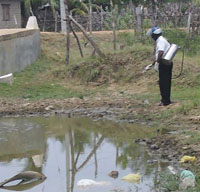
Larviciding refers to the use of chemicals or biological agents or toxins to kill mosquito larvae. Water collections that cannot be managed by environmental control measures can be dealt with by larvicides. Like environmental control measures, the success of larvicides will depend on the identification of mosquito breeding sites and their distribution in the area, followed by sustained weekly spraying of chemicals (figure below). Larvicides should be applied in conjunction with other environmental control measures.

A chemical called Temephos has been the most widely used mosquito larvicide worldwide. Temephos is highly active against the nervous system of mosquito larvae and other aquatic insects, and a relatively low dosage can kill them before they reach the adult stage. Its toxicity (ability to poison) fish, birds, humans and other mammals is very low. Its low toxicity to non-target organisms and low effective dosage make Temephos the most appropriate larvicide in many situations. It is recommended for the control of mosquito larvae in drinking-water and in areas where fish, birds and mammals may come into contact with it.
Unlike indoor residual spraying, larviciding requires little technical skill and therefore you can train community members to spray Temephos into breeding sites under your supervision and technical support. The instructions are given in the box below.